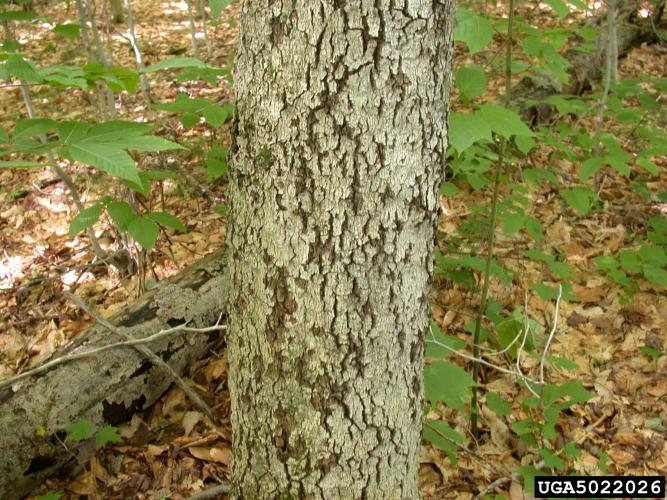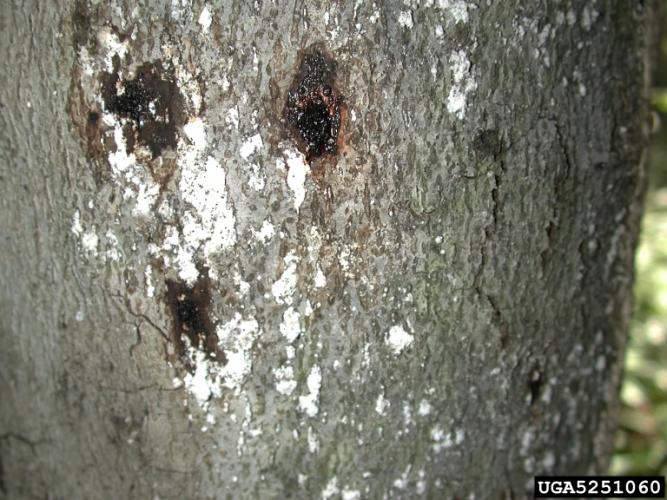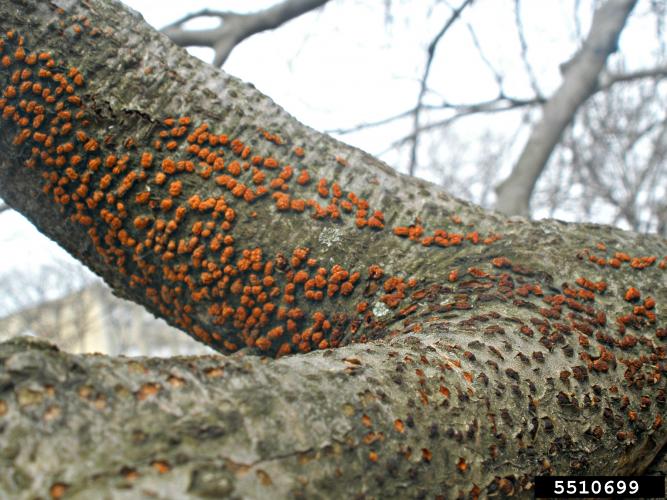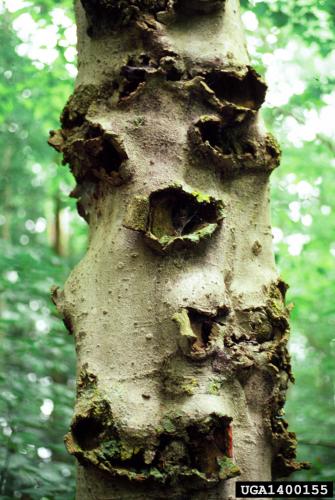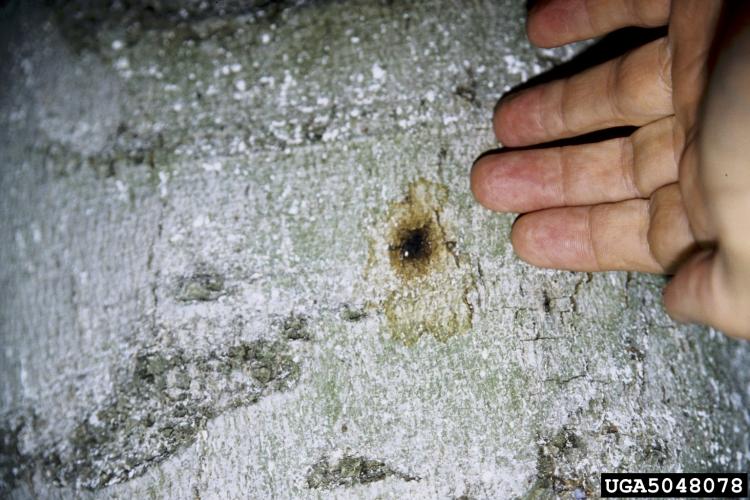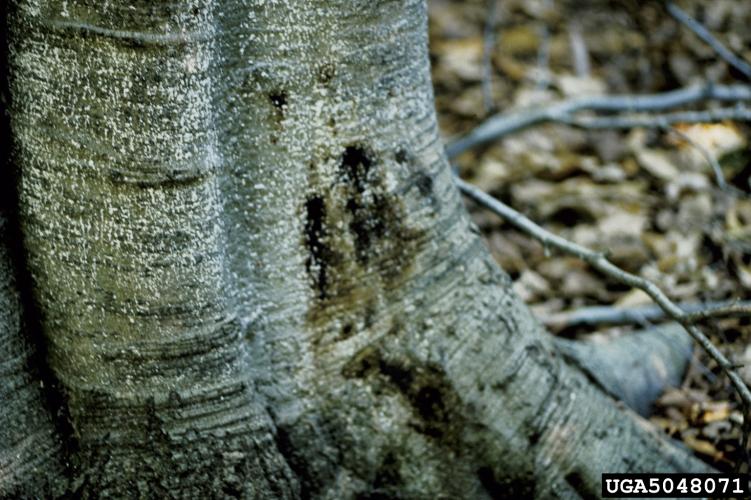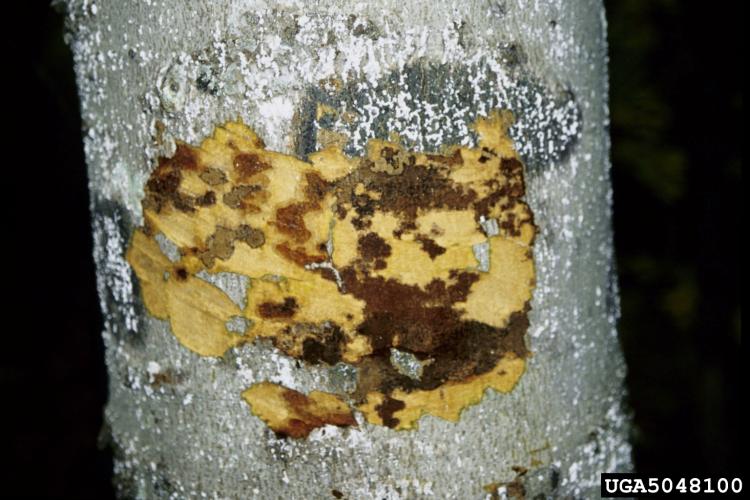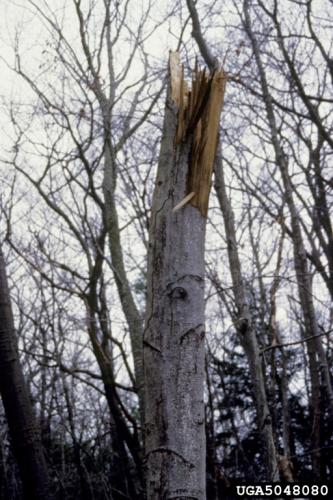Beech Bark Disease
Identification
Beech Bark Disease is caused by a scale insect and fungus complex that attacks the American Beech (Fagus grandifolia). The scale feeds on the superficial layer of the beech bark, creating a vulnerable spot that allows for infection to occur by the Nectria fungus.
Beech Scale (Cryptococcus fagisuga) is a soft bodied, yellow insect. It is elliptical shaped at maturity, reaching a maximum size of 0.5-1 millimeter in length. The scale body has rudimentary legs and antennae, reddish brown eyes and a two-millimeter long stylet for feeding. The wool-like wax secreted by the beech scale can be seen visually. There are three life stages that the beech scale goes through within a life cycle of one year.
Signs and Symptoms
Beech scales are first evident as dots of white wooly wax on the bark. This white wax-like substance will often appear on roughened areas, beneath moss and lichens and below branches. If several scales feed close to each other the cells in the tree’s cambium layer will shrink, creating fissures in the bark. This creates a wound in which the fungal pathogen can become established and begin the process of beech bark disease.
The fungal infection is sometimes seen as a slimy flux or “tarry spot” that begins to ooze from dead spots on the bark. If the bark is cut away, the inner layer will appear orange in color. As the disease progresses the fungal hyphae spread through the vascular tissue of the tree and cankers form on the tree’s bark.
This will eventually result in the girdling of the tree, preventing nutrients from traveling through the trunk and branches. Infected trees are not always girdled; some may be infected in a strip up the trunk. A fungal infection is also visible due to its red or white fruiting bodies on the bark’s surface.
A diseased tree may develop a thinning crown, immature leaves, yellowing leaf coloration and dead limbs. Trees infected with beech bark disease are extremely vulnerable to other environmental factors including drought, diseases, and insects. Many infected trees succumb to “beech snap”, where compromised trees are snapped by high winds.
See image slideshow above for signs and symptoms.
Biology
origin
There are accounts of the beech scale in Europe dating back to 1849. Around 1890 the scale insect was unintentionally transported to Nova Scotia on a shipment of ornamental beech. By 1932 the scale insect had dispersed and spread to coastal regions of Maine and later established populations in regions such as New England, Quebec, New Jersey and Pennsylvania. Beech Bark Disease was found to be widespread in the Green Mountain National Forest by 1955, with an estimated 30% of the American Beech population infected by the 1980s.
Lifecycle
The life cycle of the beech scale insect is of importance because without the opening created by the scale, there could be no fungal infection.
Reproduction for the beech scale insect is parthenogenetic, meaning that there are no male beech scale insects and reproduction occurs without the infusion of male and female gametes. During midsummer the mature scale insects deposit four to eight pale yellow eggs on the bark of a beech tree in a string-like form. The deposited eggs begin to hatch in late summer and continue to hatch into the early winter. Wingless larvae, also known as crawlers or nymphs, emerge. The crawlers, like their name suggests, have well developed legs and antennae. During this first life stage crawlers will disperse, either staying on the same beech tree or moving via the wind, rain, birds, or humans (through firewood) to another beech tree. Those that survive begin to feed by forcing their tubular stylet into the bark of the tree. The successful feeding brings the crawler into the next life stage where they become a legless nymph, overwintering in this stage in a wool-like substance. Over the winter months, the nymph transforms into a mature fully grown beech scale insect.
Two species of Ascomycete fungi (Neonectria faginata and Neonectria ditissima) commonly referred to as "Nectria", contribute to beech bark disease in North America. The fungus spores invade the open bark created by the scale insect. The fungus can be visibly seen on the bark in the form of fruiting bodies, called perithecia. The perithecia are tiny, red, and lemon shaped, each containing numerous fungus spores. The perithecia mature in the fall and push the fungus spores out into the environment. Perithecia will continue to produce spores the following year. Fungus spores are also created through an asexual or vegetative process in the bark of a beech tree, appearing before the perithecia. Asexual spores can be found mid-summer to fall and are disseminated by the wind.
The advance of the disease through the northeast is categorized into three phases:
- Advancing front
- Scale insect disperses through the region
- Scale feeding causes alterations to patches of bark
- Killing front
- Begins one to nineteen years after arrival of scale insect
- Scale modified bark is killed and colonized by Nectria fungus
- Mortality and snap (stem breakage) levels as high as 50% in five years
- Aftermath forest
- Ecological accommodation of Beech Bark Disease, change in species composition
- Sprouts emerge from beech stumps that are genetically identical to disease-killed beech, and easily infected.
Threat
Beech trees are a very important species to Vermont, being one of the predominant species of the Northern Hardwood Forest (along with Sugar Maple and Yellow Birch). Beech trees are not only important due to their high density in the forests of Vermont but also because of the function of mast production for the animals of the area. Beech trees are one of the few tree species in Northern Vermont that produce edible nuts, and the only species in the Northeast Kingdom. Beech nuts are a vital food source for a number of animals in this area including black bears, white-tailed deer, marten, fisher, wild turkeys, ruffled grouse and other mammals and birds. Beech nuts contain five times the fat content of corn and twice the fat content of white acorns. This food source is especially important for the black bear population, particularly during the months preceding hibernation and reproduction.
Beech trees are also an important source of firewood for humans, as its wood burns slowly and puts out equivalent heat to sugar maples, oaks and birch species.
There are multiple environmental controls that keep Beech Bark Disease from completely eliminating the species. Some beech trees are immune to beech scale, others survive many years in spite of infection. Beech sprouts prolifically, and the young trees are more likely than other native hardwoods to survive when deer numbers are high. Scale insects can be killed off by extremely cold temperatures (-35°F), though many survive these temperatures by being insulated in the snow.
The Ladybird Beetle (aka Ladybug) is a predator to the beech scale insect. There is also a fungus that parasitizes the Nectria fungus.
Vermont Distribution
Beech bark disease has spread throughout Vermont.
Citations
Photo Credit
Pennsylvania Department of Conservation and Natural Resources- Forestry, Bugwood.org
Joseph OBrien, United States Department of Agriculture, Forest Service, Bugwood.org
Linda Haugen, United States Department of Agriculture, Forest Service, Bugwood.org
Ansel Oommen, Bugwood.org
information credit
Michigan Extension: Biology and Management of Beech Bark Disease
USDA Forest Service Fact Sheet
VT ANR Management Guidelines for Optimizing Mast Yields in Beech Mast Production Areas
